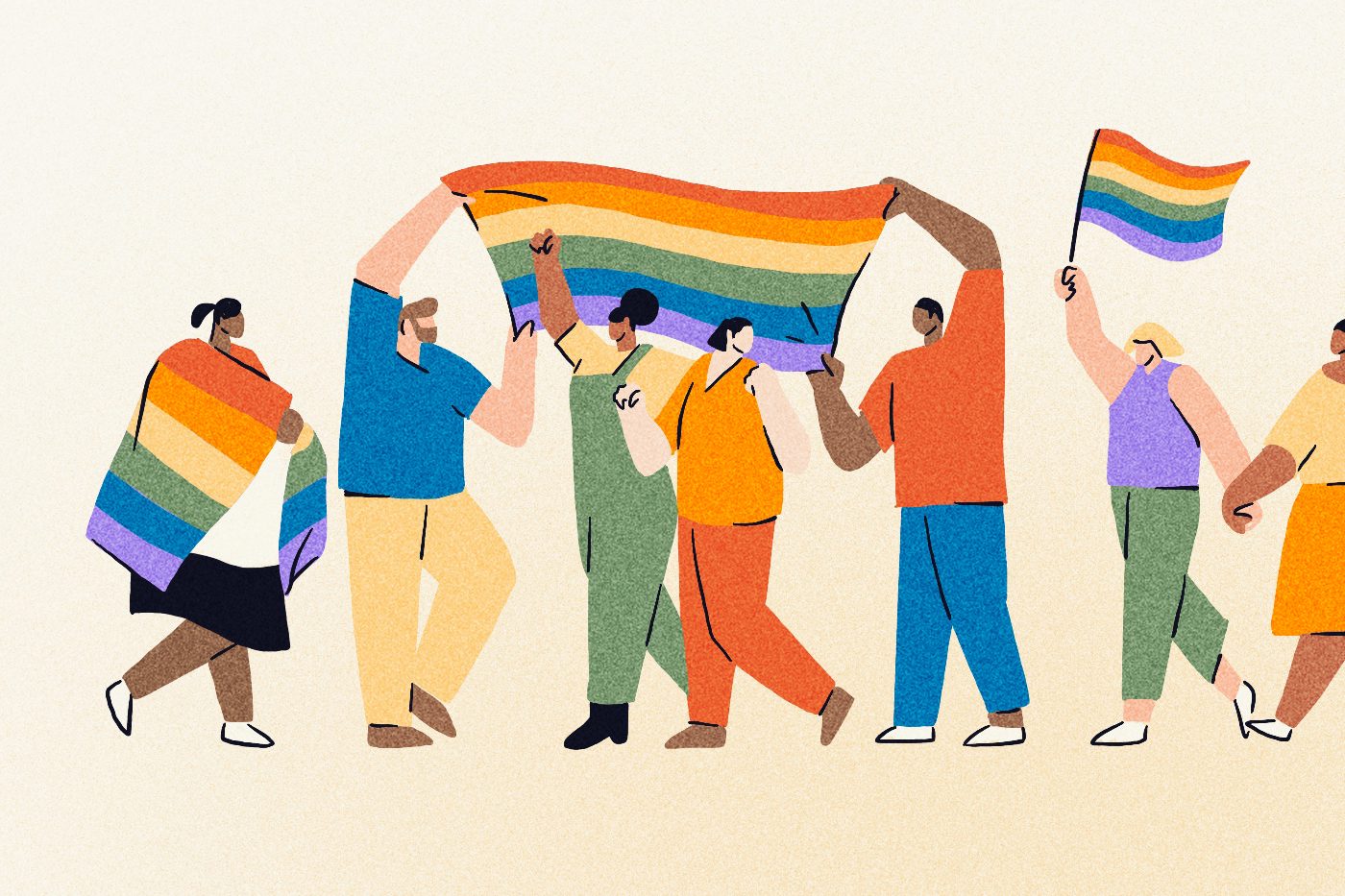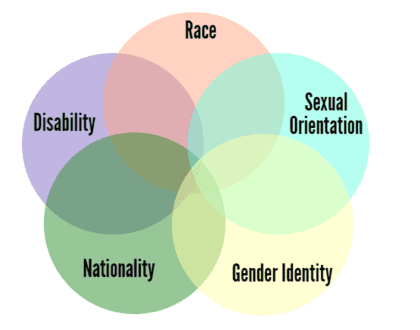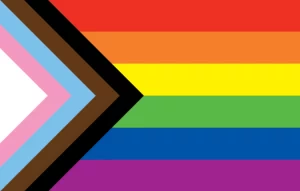Intersectional Pride Month Marketing
- What is intersectionality?
- What does intersectional Pride marketing look like?
- What is the story behind the intersectional Pride flag?
- 6 ways to celebrate intersectional pride in your campaigns
- 1. Remember why we celebrate Pride and recognize who led the original movement.
- 2. Recognize and acknowledge differences.
- 3. Understand the differences and between sex, gender and sexual orientation.
- 4. Assess the space you're in and how you exist in it.
- 5. Seek viewpoints outside of your own and get uncomfortable.
- 6. Speak up, show up, and make your voice heard.
- If your Pride Month campaign isn't intersectional, it isn't a Pride Month campaign.
Our identities intersect. Can marketing tactics ever address them respectfully and ethically?
Everyone has an identity – that’s a given. But sometimes, we have many.
Race, ethnicity, gender, sexuality, ability, socioeconomic status; these are a few of a multitude of identities that shape how we view and interact with the world around us.
And when these multiple identities overlap, they create unique experiences that vary from person to person.

In previous pride months, we’ve talked about year-round allyship and how every person — lesbian, gay, trans, non-binary, allies, and everyone in-between — has varying opinions about Pride Month Marketing (and rainbow products). For this year’s celebration, we want to call out the relationship between marketing and intersectionality — the notion that our unique, individual experiences regarding discrimination and oppression shapes our livelihoods, mindsets and worldviews. Intersectionality runs the gamut from race, ethnicity, gender and sexual orientation to physical ability, socioeconomic status and even education.
Here’s the big question: how can we, as marketers, ethically address intersectionality in our Pride Month campaigning? Let’s dive in.
What is intersectionality?

Intersectionality was coined by law professor, social theorist and activist Kimberlé Crenshaw in her famous 1989 essay, which debunked the long-held belief that race and gender were mutually exclusive categories of experience and analysis.
In her essay, Crenshaw coined the term “intersectionality” to describe erasure, violence and bias against Black women, especially in feminist theory, politics and practice.
This confluence of two states of identity — being Black and being a woman — fall under two marginal and oppressed communities, resulting in an experience that will widely differ from, say, a white woman’s.
Crenshaw’s framework is widely used now in global conversations about racial justice, policing, LGBTQIA+ liberation, and identity politics.
As The Center for Intersectional Justice aptly puts it, “intersectionality is about fighting discrimination within discrimination, tackling inequalities within inequalities, and protecting minorities within minorities.”
What does intersectional Pride marketing look like?
Let’s talk about Target.
For years, in June, the superstore has boasted a feast of Pride products. such as “Tired and gay” and “igualdad” (“equality” in Spanish) mugs. According to last year’s media release, Target’s 2022 “Take Pride” campaign featured its widest product assortment yet.
And they did it the right way: Each and every product was designed by either a non-cisgender person or non-heterosexual person, with proceeds and recognition going directly to these individuals. Better yet, Target donated $250,000 to GLSEN, who creates accessible, antiracist, gender-affirming spaces for LGBTQIA+ students.
They doubled down on their 2021 pledge to invest $2 billion in Black-owned businesses, and is the perfect example of a brand that is fully aware that race, gender, sexuality and access to care are not mutually exclusive, and can impact one person in multiple ways.
As Target recruits these members of the LGBTQIA+ community, they send the message that they’re actually trying to do something to help spark change and show support. And they’re putting their dollars to work to show it.
Pride was a beacon of intersectional queer allyship until this year, when they made the controversial decision to remove or relocate its collection because of threats from violent extremists. Many have questioned Target’s decision to bend to anti-LGBTQIA+ pressure, rather than increasing measures that protect their employees and products. It’s an important lesson in how even a superbly crafted campaign can falter when you cave to extremist pressure.
What is the story behind the intersectional Pride flag?
In 2018, non-binary artist Daniel Quasar created the Progress Pride Flag, which adds black and brown stripes to the ubiquitous 6-color design. These additions highlight the often overlooked BIPOC (Black, Indigenous, and People of Color) queer community that ignited the entire Pride movement with the Stonewall Riots in 1969.

The pink and light blue of the transgender flag are also included, uniting with the black and brown stripes to form a triangle — suggesting a forward-moving arrow. This brings intersectionality into the Pride conversation and is a strong reminder that there are plenty of identities beyond white, cisgender English-speakers who fall under the L, the G, and the B (a group historically at the forefront of conversations about gay rights in America — and the focus of marketing efforts).
6 ways to celebrate intersectional pride in your campaigns
Maybe your brand isn’t a multibillion-dollar conglomerate like Target. But you can still create a campaign that resonates, creates work for intersectional, LGBTQIA+ identifying individuals, and gives back to the community at large.
Here are some ways to start.
1. Remember why we celebrate Pride and recognize who led the original movement.
To understand Pride Month is to once again understand why we celebrate Pride Month, and celebrate just who championed the progress we’ve made today.
Any rights the LGBTQIA+ community earned started with the uprisings of the 1950s, ‘60s, early ‘70s and beyond — by Black and BIPOC (Brown and Indigenous People of Color), all of whom have intersectional identities.
Here’s where that intersectionality really came to play: While already marginalized because of their racial identities, the leaders of LGBTQIA+ liberation were further discriminated against — even in their own communities — because of their identities as trans, non-heterosexual or non-cisgender.
2. Recognize and acknowledge differences.
As comedians Meg Stalter and Eric Sedeño put it, Pride marketing can be outright cringy.
When you create one target audience for Pride, you run the risk of assuming that all LGBTQIA+ people fit into the same persona box – and you’re betting on the hope that they’ll be receptive to your vague marketing efforts and performative outreach. By that point, you’ve missed the point entirely.
While you may worry that it will be perceived as rude to acknowledge a specific experience or (tastefully) call out differences, it’s not. It’s okay to understand that everyone experiences life differently based on their intersecting identities.
You and your campaigns will be better for it.
3. Understand the differences and between sex, gender and sexual orientation.
These terms are important. We hear sex, gender and sexual orientation all the time, but how can we understand the difference?
Sex
The sex referred to by this definition has to do with what you’re assigned at birth. It’s based on the medical gaze and body mapping: genitals, chromosomes and hormones.When we’re born, a doctor assigns one of two labels: female or male. If this anatomy doesn’t align with female or male, doctors may assign intersex, the “I” of the LGBTQIA+ acronym.
While even referring sex to biological standards can veer into problematic nature, it’s best to refer to sex as “assigned [female/male] at birth.”
Gender
Gender refers to a social construct — the rules, expectations and standards of behavior set forth for people assigned female and male at birth.
Gender also includes gender roles, which are the thoughts, actions and character traits associated with what we’re medically assigned.
Most importantly, gender identity is how we feel internally, and express these feelings externally. This is where the gender binary, the idea that there are only two genders, becomes fully debunked. People whose assigned sex at birth is intersex may not be defined as female or male, but this classification isn’t rigid.
Currently, multiple genders — and more — exist: non-binary, gender fluidity, genderqueer, agender, amongst others.
Consider that your audience may identify as neither male nor female. Our own experiences are not the definitive framework or baseline for others. They’re ours for a reason, and not one person was meant to experience life the same way you were.
Once you understand that gender exists beyond a binary, and that our genders are not defined by our bodies, you can rid yourself of the notion that sex —which was not chosen by us — is not definitive of our identities.
Sexual orientation
Sexual orientation refers to, simply, who you’re attracted to — sexually and romantically.
Sexual orientation is not contingent on your gender identity. You can be trans and heterosexual, non-binary and bisexual, cisgender and gay or lesbian. But these are just a few of many possible examples.
Once you’ve brushed up on these basics and can clearly understand the difference between sex, gender and sexual orientation, you can begin to do even more work.
4. Assess the space you’re in and how you exist in it.
Privilege still exists within the LGBTQIA+ community. When you advocate or attend rallies, parades and forums, see who’s there, who isn’t, and ask yourself what you think this means.
Some 40% of LGBTQIA+ U.S. adults are people of color, while more and more of the burgeoning Gen-Z population — 48% of whom are from communities of color — identify as LGBTQ+.
One should also always consider representation for people with disabilities, which comprises nearly one-third of the LGBTQIA+ community.
Diversity is what drives change. As differing cultural experiences, worldviews and identities intersect to shape our lives, diverse representation is imperative.
How do you exist in these spaces? How do you assert your privilege, uplift others or do your part? These are all things to think about, especially from a marketing perspective.
5. Seek viewpoints outside of your own and get uncomfortable.
The only way to learn is to be uncomfortable, and there’s a lot to learn — and even more to discover — about our history marginalizing LGBTQIA+ people, especially those with intersectional identities .
But once you do the work, acknowledge the past and assess your own preconceived notions and unconscious biases, you and your brand can be all the better for it.
That key word — acknowledgment — is a major step forward. We can always be better.
Check out this list of valuable reads on intersectionality.
6. Speak up, show up, and make your voice heard.
Making a difference and sparking change starts with each and every one of us.
Once we’ve done the work, addressed how intersectionality impacts — or benefits — us, and made our presence known, our opinions heard and offered our support, we can create an accepting, inclusive culture. This goes for our lives, our workplaces and in what we create to try and connect with the LGBTQIA+ community.
If your Pride Month campaign isn’t intersectional, it isn’t a Pride Month campaign.
It’s easy to misstep, and not do things perfectly. You should rely on a marketing agency with proven experience in creating inclusive work for intersectional audiences. Contact us today so we can help you get started.

